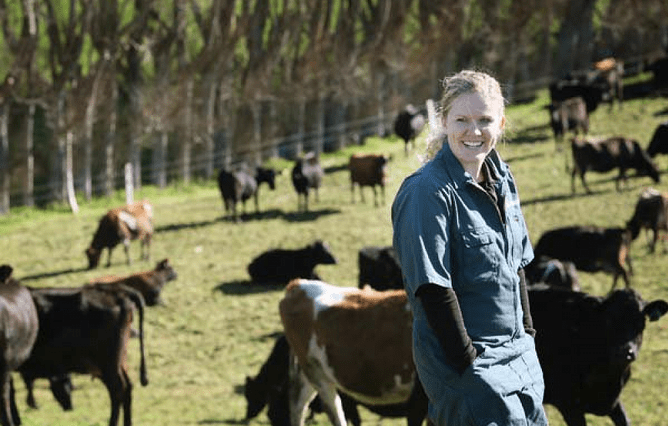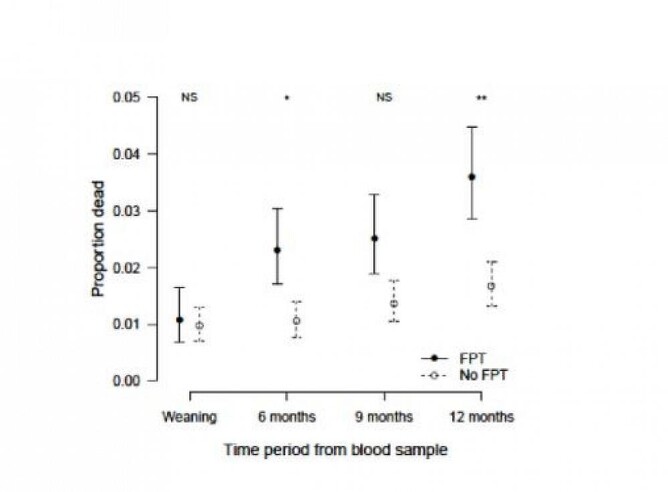Dr. Emma Cuttance visited us recently to discuss FPT in calves. Failure of passive transfer in dairy calves is associated with greater susceptibility to disease and mortality, so what can be done? Key Points
- Failure of Passive Transfer (FPT) occurs when calves fail to absorb sufficient quantities of immunoglobulin from colostrum in the first 24 hours of life.
- A recent New Zealand study indicates that, on average, about a third of calves (i.e. 33%) have FPT, but this prevalence varies widely between farms from 5% up to 80% of calves.
- Calves with FPT are immune compromised and, therefore, at a greater risk of disease and mortality. This effect is still evident at 12 months of age.
- Strategies to improve quality and timely intake of colostrum will result in improved health and survival.
Rearing healthy, high genetic merit replacement stock is key to the future productivity of a herd, and management strategies for stock health start from day 0. This is because calves are born with a poorly developed immune system.
Unlike humans, the bovine placenta prevents the transfer of large immunoglobulin molecules (antibodies), which are essential for immunity, from crossing the placental-blood barrier and into the fetal calf. Instead, newborn calves must ingest colostrum to absorb immunoglobulins across their intestinal wall and obtain sufficient immunity until their own immune system becomes functional. This transfer of immunity via colostrum is most effective in the first 24 hours after birth and is often referred to as ‘passive transfer’.
When calves receive sufficient quantities of good quality colostrum there are measurable, high concentrations of immunoglobulin in their blood. Calves that fail to absorb sufficient quantities of immunoglobulin in those first 24 hours suffer from Failure of Passive Transfer (FPT) of immunity. FPT can be identified by analysing blood samples for concentrations of immunoglobulin G (IgG) or total protein (TP). IgG concentrations less than 10 g/L or TP concentrations less than or equal to 52 g/L are considered positive for FPT. To assess herd prevalence of FPT, samples should be collected from healthy calves only between 24 hours and 7 days of age.
In overseas studies, FPT has been reported to affect, on average, 19 to 40% of calves. A similar prevalence has been recently reported in New Zealand. In a 2015 study of c.4000 dairy calves, from 106 seasonal pasture-based farms across 9 different regions, 33% of calves had FPT, but the prevalence ranged between 5% and 80% on individual farms. This study indicated many calves are not getting enough good quality colostrum immediately after birth to ensure passive immunity.
What are the effects of FPT?
Internationally, FPT has been reported to increase the risk of mortality, disease and ill-thrift in dairy calves, and has been associated with long-term reductions in animal productivity. Calves with FPT are more susceptible to diarrhoea, respiratory disease, septicemia and enteritis. FPT can also lead to under development of the digestive tract and lower feed intake, resulting in reduced growth and subsequent milk production.
In the recent New Zealand study, the effects of FPT (serum total protein [STP] ≤52 g/L at 1-7 days of age) on mortality, morbidity and body weight were investigated from birth until weaning. Of the c.4000 calves, a subset of c.2000 (representing 35 farms in the Waikato and Canterbury regions) were monitored until 12 months of age to ascertain the longer-term effects of FPT.
Animal health
Calves with FPT were twice as likely to have a farmer-recorded animal health event (e.g. diarrhoea) compared with calves without FPT. While specific diseases were not analysed separately, this relationship is similar to international findings. In the Netherlands, calves with IgG concentrations <7.5 g/L were twice as likely to develop respiratory disease. In North America, the odds of having a veterinary-diagnosed respiratory disease were two-fold greater in calves with serum IgG between ≤8.0-13.0 g/L compared with calves with serum IgG >13 g/L. Therefore, if calf immunity via passive transfer can be improved, the risk of disease during the period from birth to weaning will be reduced.
Mortality
Surprisingly, mortality did not significantly differ pre-weaning; rather, the heightened mortality risk for FPT-affected calves occurred between 6 to 12 months of age (Figure 1). By 12 months, 3.5% of heifers that had FPT as calves had a died, whereas those that did not have FPT had a mortality rate of 1.8%.
Fig. 1. The difference in the mortality between calves with failure of passive transfer (FPT; serum total protein ≤52 g/L) and calves without FPT at different ages. Vertical bars represent the 95% CI.
The increased risk of mortality in calves with FPT is consistent with findings from international studies. In a 10-year study in North America, researchers measured the mortality risk of c.3500 Holstein replacement calves up to 4 months of age on a farm with endemic salmonellosis. They reported that survival rates increased for each 5 g/L increase in TP concentration up to 60-64 g/L. In particular, calves with TP concentration <40 g/L had a 4.6 times greater risk of mortality than calves with TP concentration of 60 g/L. Another North American study of c.3300 Holstein heifer calves indicated mortality risk between 0 and 6 months of age decreased when TP concentration increased from 40 g/L to 60 g/L, but there was no further improvement above 60 g/L.
It is logical that a young calf affected by FPT is more prone to succumbing to a serious disease challenge. Yet, why do the results from the New Zealand study indicate that calves with FPT had approximately double the odds of mortality from weaning up to 12 months of age but not before weaning? A possible explanation is that the relationship between FPT and mortality may become more apparent post-weaning when heifers are often reared off the milking platform and, therefore, observed less frequently for detection and treatment of disease than during the pre-weaning calf rearing phase.
Body weights
FPT was associated with a significantly lower body weight at weaning, 6, 9 and 12 months of age; however, these differences were minor, ranging from 0.93 kg at weaning (88.77 kg vs 89.70 kg) to 3.30 kg at 12 months (240.92 kg vs 244.22 kg). It is possible that these results were influenced by the separation and preferential feeding of underperforming animals identified by the farmer or grazier. Therefore, if the slower growing calves were, in fact, those with FPT they would have been unknowingly preferentially fed by the farmer or grazier. This may mean that the effect of FPT on body weight may be larger than measured in this study.
Nevertheless, several international studies also indicate that FPT has only a small negative effect on body weight. In America, c.2900 heifer calves were monitored from birth to 3 months of age on 19 commercial dairy farms14. Only a small (0.76 kg) decrease in body weight was reported for calves with FPT (STP concentration of ≤ 52g/L)10. Researchers in Belgium observed that calves with STP concentration <7.5 g/L grew, on average, 79 g/day less than calves with STP concentration >7.5 g/L, which equated to a difference of 1.8 kg from approximately 3 to 6 weeks of age. In a study conducted in Poland, calves with different serum immunoglobulin concentrations at 30 to 60 h of life (<5, 5–10, 10–15, or >15 g/L) were monitored until one year of age, with no difference in body weight gain detected for the first 6 months. There were some growth differences between certain groups and certain time points after 6 months but these were limited.
Conclusions
Failure of passive transfer in dairy calves is associated with greater susceptibility to disease and mortality, and the high prevalence of FPT detected in the New Zealand study indicates significant improvement is needed on some farms. Management practices to ensure sufficient quality colostrum is consumed within the first 24 hours will lead to improved health and survival outcomes for replacement heifers. For more information on colostrum management, visit www.dairynz.co.nz/animal/calves/calf-care/
Steps to prevent FPT
- Do you have a problem? Blood test 12 calves this season and find out.
- Newborn calves should only be fed first milking colostrum, 6 to 12 hours after they have calved.
- Clean is key – do not leave colostrum to sit without a preservative or refrigeration and a lid! And remember anything you stir it with could also introduce bacteria. If you would not drink it, don’t feed it to the calves. The bacteria inhibit absorption of antibodies.
References
- Wesselink, R., K. J. Stafford, F. J. Mellor, S. Todd, and N. G. Gregory. 1999. Colostrum intake by dairy calves. New Zealand Veterinary Journal 47: 31-34.
- Beam, A. L., J. E. Lombard, C. A. Kopral, L. P. Garber, A. L. Winter, J. A. Hicks, and J. L. Schlater. 2009. Prevalence of failure of passive transfer of immunity in newborn heifer calves and associated management practices on US dairy operations. Journal of Dairy Science 92: 3973-3983.
- Cuttance E., W. Mason, R. Laven, J. McDermott, and C. Phyn. 2017. Prevalence and calf-level risk factors for failure of passive transfer in dairy calves in New Zealand. New Zealand Veterinary Journal, 1-22.
- Tyler, J. W., S. M. Parish, T. E. Besser, D. C. Van Metre, G. M. Barrington, and J. R. Middleton. 1999. Detection of low serum immunoglobulin concentration in clinically ill calves.Journal of Veterinary Internal Medicine13: 40-43.
- Tyler, J. W., D. D. Hancock, S. E. Wiksie, S. L. Holler, J. M. Gay, and C. C. Gay. 1998. Use of serum protein concentration to predict mortality in mixed-source dairy replacement heifers. Journal of Veterinary Internal Medicine 12: 79-83.
- Virtala, A. M. K., Y. T. Gröhn, G. D. Mechor, and H. N. Erb. 1999. The effect of maternally derived immunoglobulin G on the risk of respiratory disease in heifers during the first 3 months of life. Preventive Veterinary Medicine 39: 25-37.
- Donovan, G. A., I. R. Dohoo, D. M. Montgomery, and F. L. Bennett. 1998. Associations between passive immunity and morbidity and mortality in dairy heifers in Florida, USA. Preventive Veterinary Medicine 34(1): 31-46.
- Furman-Fratczak K, Rzasa A, Stefaniak T. 2011. The influence of colostral immunoglobulin concentration in heifer calves’ serum on their health and growth. Journal of Dairy Science 94, 5536-43.
- Pardon B, Alliët J, Boone R, Roelandt S, Valgaeren B, Deprez P. 2015. Prediction of respiratory disease and diarrhea in veal calves based on immunoglobulin levels and the serostatus for respiratory pathogens measured at arrival. Preventive Veterinary Medicine 120, 169-76.
- Windeyer M. C., K. E. Leslie, S. M. Godden, D. C. Hodgins, K. D. Lissemore, and S. J. LeBlanc. 2014. Factors associated with morbidity, mortality, and growth of dairy heifer calves up to 3 months of age. Preventive Veterinary Medicine 113, 231-40.


